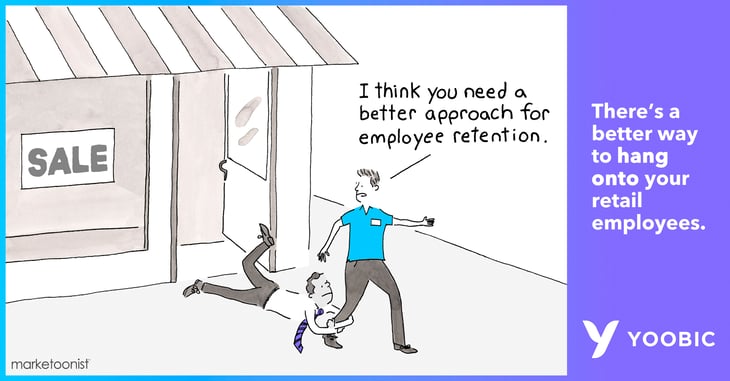Aug 25, 2022 12:00:40 PM
Employee experience | Retail | Marketoonist
Aug 25, 2022 12:00:40 PM
Employee experience | Retail | Marketoonist

Employee retention will always be a challenge for retailers, but high turnover doesn’t have to be inevitable. Best-selling author of Retail Pride, Ron Thurston, shares his personal best practices to improve retail employee retention!

Here's a reality check… there will always be employee turnover, and retail employee retention rates have always been higher than in other industries and will likely continue to be high.
That might be hard to hear, but the average employee turnover for all U.S. industries is around 19%, yet the average turnover rate in the retail sector is just above 60%, according to the National Retail Federation. This equates to a continual cycle of rehiring and retraining, with a negative impact on retailers' bottom lines if not managed well.
As a retail executive who has led large field teams, retention has always been part of the conversation, because crossing your fingers and saying "I don't know what we will do if she leaves" isn't a strategy. In addition, Gallup reported that more than half of workers that are voluntarily leaving their jobs say that their bosses or companies could have prevented their exit.
Here are four of my personal best practices to positively impact your team retention:
Effective, multifaceted engagement with employees of all types is challenging—but replacing them is even more complex and expensive. Leaders and organizations that invest the time to determine what employees need to stay engaged in their jobs will be most successful in keeping them. A strong employee retention strategy will also appeal to a happier, more productive workforce who inspire and elevate everyone around them… and who wouldn't want that?
Want to discover research-driven strategies for retail employee retention? We asked 1,400 frontline employees what their employers could do to make them want to stay longer in their roles.
This blog post is guest written by Ron Thurston, a highly accomplished retail leadership executive, Board Advisor, and Amazon #1 Bestselling Author of Retail Pride. Ron has extensive experience leading retail operations for America’s most prominent brands, is the host of the RETAIL IN AMERICA podcast and was featured on the 2021/2022 RETHINK Retail 100 Most Influential People list.
Search the blog

See why 350+ businesses are using YOOBIC
YOOBIC creates a better everyday working experience for frontline teams while helping businesses drive performance at scale.
PRODUCT
See why 350+ businesses are using YOOBIC
YOOBIC creates a better everyday working experience for frontline teams while helping businesses drive performance at scale.